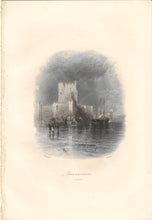Artist: Thomas Creswick RA (1811 – 1869) was an English landscape painter and illustrator, after.
Engraver: Robert William Wallis (1794 – 1878) was an English engraver.
Title: Carrickfergus. Antrim.
Knight John de Courcy built Carrickfergus Castle on the "rock of Fergus" in 1177. The castle, which is the most prominent landmark of Carrickfergus, is widely known as one of the best-preserved Norman castles in Ireland. (Wikipedia).
Signed by both artist and engraver beneath the image, and Titled lower middle.
Dimensions: Image 5" x 4 1/4". Sheet 10" x 6 7/8".
Edition: Picturesque scenery in Ireland drawn by T. Creswick, with descriptive jottings by a tourist.
Date: 1828-1836 (circa) (circa). (The British Museum).
Materials and Techniques: Engraving and etching, printed on wove paper. The reverse side is plain.
Condition: The sheet was taken from a discarded book. The reverse side is plain. Some binding remnants to the left margin. A detailed condition report is available on demand.
Part of: illustration to an unidentified publication.
Museums and Libraries: The British Museum. Registration number
1926,0331.591.
Note: The British peerage title of Baron Carrickfergus, which had become extinct in 1883, was bestowed upon Prince William on his wedding day in 2011. (Wikipedia).





